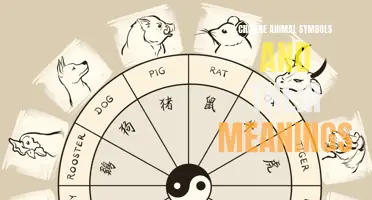
Shamanism, a spiritual practice rooted in ancient cultures around the world, has long been surrounded by mysticism and enigmatic symbolism. Within this captivating realm, symbols play a vital role in communicating profound insights and connecting individuals to the spiritual realm. These symbols, rich in meanings and representations, hold the power to unlock hidden wisdom, heal the soul, and guide individuals on their spiritual journeys. From animal spirits to sacred plants, each symbol tells a story and carries a deep significance that transcends language and logic, reaching into the profound depths of the human psyche. Join us as we explore the captivating world of shaman symbols and unravel the hidden messages they hold.
What You'll Learn
- What are some common shaman symbols and their meanings?
- How have shaman symbols and their meanings evolved over time?
- Are there different variations of shaman symbols and meanings across different cultures?
- How are shaman symbols and meanings used in modern spirituality and New Age practices?
- Can you provide examples of specific shaman symbols and their deep spiritual significance?

What are some common shaman symbols and their meanings?
Shamanism is an ancient spiritual practice that has been followed by indigenous cultures for thousands of years. Shamans, who are highly respected spiritual leaders and healers, communicate with the spirit world on behalf of their community. Throughout the centuries, shamans have employed various symbols to represent their beliefs and communicate with the spiritual realm. These symbols hold deep meanings and are considered sacred in shamanic traditions.
One commonly recognized shaman symbol is the drum. The drum serves as a powerful tool for shamans during sacred rituals and ceremonies. The rhythmic beats of the drum can induce a trance-like state, allowing the shaman to travel between the physical and spirit worlds. The drum represents the heartbeat of Mother Earth and the collective heartbeat of humanity.
Feathers are another important symbol in shamanism. Feathers are seen as a connection to the spirit realm and are often used by shamans in their ceremonial dress. Each feather holds a unique significance, representing different qualities and attributes of the spirits. For example, eagle feathers are associated with strength and courage, while owl feathers are linked to wisdom and intuition.
The circle is a fundamental symbol in shamanic traditions. It represents unity, wholeness, and the cycle of life. The shaman's journey begins and ends in a circular fashion, symbolizing the perpetual nature of the spiritual realm. Circles are often drawn or created during shamanic rituals to provide a sacred and protected space for the shaman and participants.
The snake is another powerful symbol in shamanism. It represents transformation, healing, and rebirth. In many shamanic cultures, the serpent is believed to be a guardian of sacred knowledge and a guide to the spiritual realm. Shamans often use snake imagery in their rituals to connect with the wisdom and healing energy of the snake.
The tree of life is a symbol found in many shamanic traditions around the world. It represents the interconnection of all living beings and the spiritual energy that flows through everything. Shamans work with the tree of life to tap into this universal energy and bring balance and healing to their community.
Water is an essential symbol in shamanism, representing purification and renewal. Shamans often use water in their rituals to cleanse and purify themselves and others. Water is seen as a source of life and a conduit for spiritual energy.
These are just a few examples of the many symbols used in shamanism. Each symbol carries its own unique meaning and significance within the context of shamanic practices. As shamanism continues to be practiced and evolve, new symbols may emerge, but the underlying principles and beliefs remain deeply rooted in the spiritual connection between humans and the natural world.
The Meaning Behind Pi Symbol Tattoos: A Deep Connection to Mathematics
You may want to see also

How have shaman symbols and their meanings evolved over time?
Shaman symbols are ancient forms of communication that have been used by spiritual practitioners for thousands of years. These symbols hold deep meanings and are often used to convey important messages from the spirit world.
Over time, the meanings behind shaman symbols have evolved as different cultures and belief systems have developed. While some symbols have remained constant throughout the ages, others have changed or gained additional meanings.
The evolution of shaman symbols can be traced back to some of the earliest human civilizations, such as the ancient Egyptians, Mesopotamians, and Native Americans. These early cultures believed that symbols were a way to connect with the divine and obtain spiritual guidance.
In ancient Egypt, for example, the ankh symbolized eternal life. It was believed that by wearing or drawing this symbol, one could access the power of the gods and ensure their immortality. Similarly, the eye of Horus symbolized protection and healing.
In Native American cultures, symbols such as the dreamcatcher and the medicine wheel were used for spiritual purposes. The dreamcatcher was believed to filter out bad dreams and negative energies, while the medicine wheel represented the interconnectedness of all living beings.
As shamanism spread across different regions of the world, the meanings of symbols began to adapt to local beliefs and practices. For example, in Norse mythology, the symbol of Yggdrasil, the World Tree, represented the interconnectedness of the nine realms. It was believed to be the center of the universe and a source of wisdom and spiritual energy.
In modern times, shaman symbols have gained even more diverse meanings. Some symbols that were once associated with specific cultures are now used by people from different backgrounds to represent their spiritual beliefs. For example, the lotus flower, originally a symbol of purity and enlightenment in Buddhism, is now widely recognized as a symbol of spiritual growth and transformation.
The internet and globalization have also contributed to the evolution of shaman symbols. People can now easily access information about different symbols and their meanings from various cultures and belief systems. This has led to a blending of symbols and the creation of new ones that incorporate elements from different traditions.
However, it is important to note that the meanings of shaman symbols can vary depending on the individual or cultural context. What may represent one thing for one person may have a completely different meaning for another.
In conclusion, shaman symbols have evolved over time as different cultures and beliefs have developed. While some symbols have remained constant, others have changed or gained additional meanings. The internet and globalization have also contributed to the evolution of these symbols by allowing people to access information about different cultures and beliefs. Ultimately, the meanings of shaman symbols can vary depending on the individual or cultural context in which they are used.
What Does the Key Symbol on My Phone Mean? Decoding its Significance and Functions
You may want to see also

Are there different variations of shaman symbols and meanings across different cultures?
Shaman symbols and their meanings vary greatly across different cultures. Shamanism is a spiritual practice that dates back thousands of years and is found in various indigenous cultures around the world. Shamanic symbols are often used to communicate with spiritual beings, and they can represent various aspects of the shamanic journey and the spiritual world.
In Native American cultures, for example, the shaman symbolizes the connection between the physical and spiritual realms. The shaman often uses animal symbols to represent different qualities or powers. For instance, the eagle symbolizes strength and vision, while the bear represents healing and protection. These symbols help the shaman connect with the animal spirits and draw on their energy and wisdom.
In Siberian shamanism, symbols play a crucial role in the shamanic rituals and practices. The shaman often uses drums or rattles adorned with symbolic motifs to enter into a trance and communicate with the spirit world. These symbols may depict animals, natural elements, or celestial bodies, each carrying a specific meaning or message.
In Norse shamanism, symbols such as the Yggdrasil tree, the hammer of Thor (Mjolnir), and the Valknut are commonly used. The Yggdrasil tree symbolizes the interconnectedness of all things in the universe and acts as a conduit between different realms. The hammer of Thor represents protection and strength, while the Valknut is associated with the interplay of life, death, and rebirth.
In ancient shamanic practices from Asia, symbols such as the Yin and Yang, the lotus flower, and the Tibetan dorje are used. These symbols embody concepts of balance, harmony, spirituality, and enlightenment. The Yin and Yang symbolizes the interconnectedness and dualistic nature of existence, while the lotus flower represents purity and spiritual enlightenment. The Tibetan dorje is a ritual object used by shamans and symbolizes indestructibility and inner strength.
The meanings of shamanic symbols are often passed down through oral tradition and vary from culture to culture. Although certain symbols may have similar meanings across different cultures, the nuances and interpretations can differ. It is important to take into account the cultural and historical context when studying shaman symbols and their meanings.
In conclusion, shaman symbols and their meanings differ across cultures. These symbols play a vital role in shamanic practices and rituals by facilitating communication with spiritual beings and representing various aspects of the shamanic journey. Understanding the cultural and historical context is crucial in interpreting the specific meanings attached to these symbols.
The Deeper Symbolism Behind the Twin Flame Symbol
You may want to see also

How are shaman symbols and meanings used in modern spirituality and New Age practices?
Shaman Symbols and Meanings in Modern Spirituality and New Age Practices
Shaman symbols and their meanings have played a significant role in various spiritual practices throughout history. In modern spirituality and New Age practices, these symbols continue to hold power and are used to represent profound concepts and mystical experiences. Understanding the symbolism behind these ancient shamanic icons can provide valuable insights into personal growth and spiritual development.
Shamanism is an ancient practice that dates back thousands of years and is found in various cultures around the world. Shamans were considered spiritual leaders who could communicate with the spirit world and were entrusted with the well-being of their communities. They used symbols to represent their connection to the divine and to convey spiritual messages to others.
In modern spirituality and New Age practices, shaman symbols are often used to connect individuals with their spiritual essence and to facilitate healing and personal transformation. These symbols can be incorporated into rituals, meditations, and visualizations, allowing individuals to tap into their spiritual energy and gain a deeper understanding of themselves and the world around them.
One commonly used symbol in shamanism is the "medicine wheel." This circular symbol represents the interconnectedness of all things and the cyclical nature of life. It is a powerful tool for self-reflection and can aid in balancing one's physical, mental, emotional, and spiritual aspects. By meditating on the medicine wheel, individuals can gain a greater sense of harmony and alignment within themselves and with the universe.
Another important symbol in shamanism is the "dreamcatcher." Originally created by the Ojibwe Native American tribe, dreamcatchers were believed to filter out negative dreams and allow only positive dreams to enter a person's mind. In modern spirituality, dreamcatchers are often used as decorative items to promote restful sleep and to symbolize protection from negative energies. They are seen as a reminder to follow one's dreams and to trust in the guidance of the spiritual realm.
Animal spirits are also significant symbols in shamanism, representing different qualities and energies. Each animal carries its own unique symbolism and lessons that individuals can learn from. For example, the wolf is often associated with loyalty, intuition, and communication, while the owl represents wisdom, insight, and mystery. By connecting with these animal spirits, individuals can tap into their inherent strengths and gain guidance and support on their spiritual journey.
In addition to these symbols, shamanism also incorporates the use of sacred plants and natural elements as tools for spiritual connection and healing. Plants such as ayahuasca, peyote, and sage are used in shamanic rituals to induce altered states of consciousness and to facilitate healing and transformation. These plants are seen as allies in the journey of self-discovery and offer profound insights and experiences.
Overall, shaman symbols and their meanings continue to be an integral part of modern spirituality and New Age practices. They serve as gateways to the spiritual realm and offer individuals the opportunity to connect with higher states of consciousness and tap into their inner wisdom. Incorporating these symbols into one's spiritual practice can bring about profound transformations and help individuals navigate their spiritual journey with greater clarity and purpose.
A Guide to Understanding GMC Dashboard Symbols and Their Meanings
You may want to see also

Can you provide examples of specific shaman symbols and their deep spiritual significance?
Shamanism is an ancient spiritual practice that has been followed by various cultures around the world. It is characterized by the use of symbols and rituals to connect with the spiritual realm and to access the wisdom and healing powers of the spirits. Shaman symbols are often imbued with deep spiritual significance, representing various forces and aspects of the natural world. Here are a few examples of specific shaman symbols and their meanings:
- The Tree of Life: The tree of life is a common symbol in shamanism, representing the connection between the physical and spiritual realms. It symbolizes the cycle of life, death, and rebirth, as well as the interconnectedness of all living beings. The tree's roots represent the underworld, its trunk symbolizes the physical world, and its branches reach towards the heavens.
- The Medicine Wheel: The medicine wheel is a sacred symbol used by many Native American tribes. It represents harmony, balance, and the cycles of nature. The wheel is divided into four quadrants, each associated with a different direction (north, south, east, and west), element (earth, air, fire, and water), and season. The medicine wheel is often used for guidance, healing, and spiritual alignment.
- The Spiral: The spiral is a powerful symbol found in shamanic cultures across the globe. It represents the cyclical nature of life, growth, and transformation. The spiral can be seen in various forms in nature, such as the shape of a seashell or the pattern of a DNA molecule. It symbolizes the continuous journey of spiritual evolution and the infinite possibilities of existence.
- The Feather: Feathers are sacred symbols in shamanism, representing the connection between the physical and spirit realms. They are often used in rituals to call upon the spirits and to seek guidance and protection. Different birds' feathers carry different energies and symbolism. For example, an eagle feather is associated with strength, courage, and spiritual insight, while an owl feather is linked to wisdom and intuition.
- The Serpent: The serpent is a potent symbol in shamanic traditions worldwide. It represents transformation, regeneration, and the continuous cycle of life and death. The shedding of its skin symbolizes rebirth and renewal. The serpent is also associated with healing and wisdom, as its ability to shed its skin is seen as a metaphor for shedding old beliefs and patterns.
These are just a few examples of the many symbols used in shamanism and their deep spiritual significance. Each symbol holds unique meaning and is used by shamans to connect with the spiritual realm, seek guidance, and facilitate healing and transformation. The power of these symbols lies in their ability to tap into the collective unconscious and access the wisdom of the ages. By understanding the meanings behind these symbols, we can gain insight into the spiritual practices of ancient cultures and perhaps even apply their wisdom to our own lives.
Understanding Chevrolet Dashboard Symbols and Meanings: A Guide for Drivers
You may want to see also
Frequently asked questions
Some common shaman symbols include the deer, which symbolizes grace and gentleness; the owl, which represents wisdom and intuitive knowledge; and the snake, which symbolizes transformation and healing. Other symbols include the moon, which represents feminine energy and the cyclical nature of life, and the tree, which symbolizes growth and connection to the earth.
The shamanic drum is a powerful symbol in shamanic cultures, representing the heartbeat of Mother Earth and the rhythm of the universe. It is used by shamans during rituals and ceremonies to connect with the spirit world and enter into altered states of consciousness. The drum symbolizes the power of sound and vibration to heal, transform, and transcend ordinary reality.
The dreamcatcher is a symbol often associated with shamanism. It is believed to protect its owner from negative energy and bad dreams while allowing positive energy and good dreams to pass through. In shamanic tradition, dreams are seen as a portal to the spirit realm, and the dreamcatcher acts as a filter or sieve, catching the negative and letting in the positive.
Feathers are a powerful symbol in shamanism, representing connection to the spirit world and divine guidance. In many indigenous cultures, feathers are seen as a gift from the winged ones, who are believed to bring messages from the spirit realm. Feathers can also symbolize freedom, lightness, and the ability to soar above earthly concerns.
The labyrinth is a symbol often associated with shamanic journeys and has been used for thousands of years as a tool for deepening meditation and accessing higher realms of consciousness. The labyrinth represents the journey of life, with its twists, turns, and detours, and is seen as a pathway to spiritual growth, self-discovery, and transformation. Walking a labyrinth can help to quiet the mind, balance the energy body, and connect with the wisdom of the ancestors.







